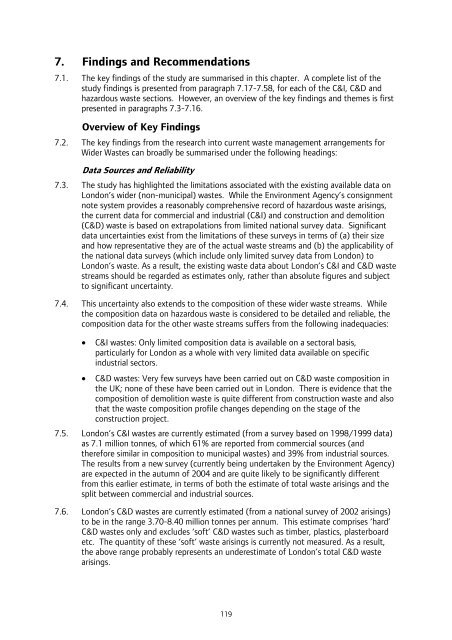London Wider Waste Strategy - London - Greater London Authority
London Wider Waste Strategy - London - Greater London Authority
London Wider Waste Strategy - London - Greater London Authority
You also want an ePaper? Increase the reach of your titles
YUMPU automatically turns print PDFs into web optimized ePapers that Google loves.
7. Findings and Recommendations<br />
7.1. The key findings of the study are summarised in this chapter. A complete list of the<br />
study findings is presented from paragraph 7.17-7.58, for each of the C&I, C&D and<br />
hazardous waste sections. However, an overview of the key findings and themes is first<br />
presented in paragraphs 7.3-7.16.<br />
Overview of Key Findings<br />
7.2. The key findings from the research into current waste management arrangements for<br />
<strong>Wider</strong> <strong>Waste</strong>s can broadly be summarised under the following headings:<br />
Data Sources and Reliability<br />
7.3. The study has highlighted the limitations associated with the existing available data on<br />
<strong>London</strong>’s wider (non-municipal) wastes. While the Environment Agency’s consignment<br />
note system provides a reasonably comprehensive record of hazardous waste arisings,<br />
the current data for commercial and industrial (C&I) and construction and demolition<br />
(C&D) waste is based on extrapolations from limited national survey data. Significant<br />
data uncertainties exist from the limitations of these surveys in terms of (a) their size<br />
and how representative they are of the actual waste streams and (b) the applicability of<br />
the national data surveys (which include only limited survey data from <strong>London</strong>) to<br />
<strong>London</strong>’s waste. As a result, the existing waste data about <strong>London</strong>’s C&I and C&D waste<br />
streams should be regarded as estimates only, rather than absolute figures and subject<br />
to significant uncertainty.<br />
7.4. This uncertainty also extends to the composition of these wider waste streams. While<br />
the composition data on hazardous waste is considered to be detailed and reliable, the<br />
composition data for the other waste streams suffers from the following inadequacies:<br />
• C&I wastes: Only limited composition data is available on a sectoral basis,<br />
particularly for <strong>London</strong> as a whole with very limited data available on specific<br />
industrial sectors.<br />
• C&D wastes: Very few surveys have been carried out on C&D waste composition in<br />
the UK; none of these have been carried out in <strong>London</strong>. There is evidence that the<br />
composition of demolition waste is quite different from construction waste and also<br />
that the waste composition profile changes depending on the stage of the<br />
construction project.<br />
7.5. <strong>London</strong>’s C&I wastes are currently estimated (from a survey based on 1998/1999 data)<br />
as 7.1 million tonnes, of which 61% are reported from commercial sources (and<br />
therefore similar in composition to municipal wastes) and 39% from industrial sources.<br />
The results from a new survey (currently being undertaken by the Environment Agency)<br />
are expected in the autumn of 2004 and are quite likely to be significantly different<br />
from this earlier estimate, in terms of both the estimate of total waste arisings and the<br />
split between commercial and industrial sources.<br />
7.6. <strong>London</strong>’s C&D wastes are currently estimated (from a national survey of 2002 arisings)<br />
to be in the range 3.70-8.40 million tonnes per annum. This estimate comprises ‘hard’<br />
C&D wastes only and excludes ‘soft’ C&D wastes such as timber, plastics, plasterboard<br />
etc. The quantity of these ‘soft’ waste arisings is currently not measured. As a result,<br />
the above range probably represents an underestimate of <strong>London</strong>’s total C&D waste<br />
arisings.<br />
119
















